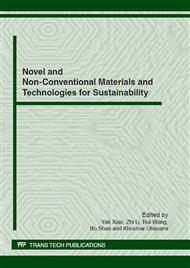p.695
p.705
p.710
p.717
p.724
p.730
p.737
p.745
p.749
Carbon Footprint Analysis of Fibre Reinforced Polymer (FRP) Incorporated Pedestrian Bridges: A Case Study
Abstract:
This paper presents a case study on the carbon footprint of a fibre reinforced polymer (FRP)-incorporated pedestrian bridge in comparison with a conventional prestressed concrete (PC) one. The CO2 emission is used as an index and calculated for both the material manufacturing and the construction processes. It is shown that using an FRP-incorporated pedestrian bridge to replace a conventional prestressed concrete (PC) bridge may reduce the CO2 emission by 18% and 70%, respectively, during the material manufacturing and construction periods, leading to a total reduction by about 26%. Such reduction is expected to be more significant if the life-cycle CO2 emission is accounted for, since the former type of bridge is free of corrosion and almost maintenance-free. Therefore, FRP-incorporated bridges may become a more competitive alternative to conventional reinforced concrete (RC) or PC ones with the increasing attention paid on the sustainability and environmental friendliness of construction industry by our society.
Info:
Periodical:
Pages:
724-729
Citation:
Online since:
June 2012
Authors:
Keywords:
Price:
Сopyright:
© 2012 Trans Tech Publications Ltd. All Rights Reserved
Share:
Citation:


